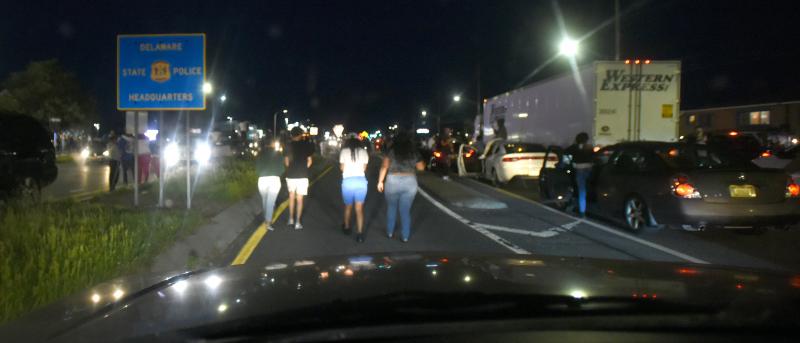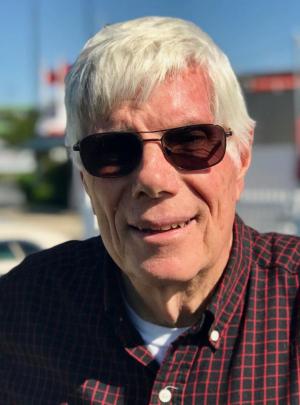Photojournalist recounts protest used as front for rioting

“Peaceful marches with hundreds of thousands of people have an effect. But the smaller, peaceful protests of the past haven’t got much attention. Violence gets the most attention, but that’s not where we want to be.” – Pete Schwartzkopf, 14th District Representative, Speaker of Delaware's House of Representatives.
Gary Emeigh, 72, has been a photojournalist in Delaware for more than 50 years. With camera in hand, the Milford resident has waded into fatal fires and crashes, protests and riots, murders and kidnappings, coastal storms and floods, from one end of the state to the other. His intent has always been the same: to capture firsthand images of the story.
But on May 31 this year, when protests rolled across the nation like wildfires in the wake of the death of George Floyd in Minneapolis at the hands of a police officer, Emeigh experienced something that he never had before.
Protesters had been active in Dover for a few hours when darkness fell that holiday evening. “The News Journal called me to get pictures. I was in the southbound lane of Route 13 near Dover Mall and Delaware State Police headquarters. There was a crowd of a couple hundred people in the middle of the road. I pulled my Escalade into the turning lane of the median and that’s where I was stopped. This big fat jerk – a white guy – stood right in front of my car. They surrounded me, all mobbed up. They weren’t protesters; they were rioters. Most of them were white, in their 20s, using ignorant language, using Black Lives Matter as a front.”
The man who had stood in front of Emeigh’s vehicle to stop his progress then walked around to the driver’s side window and reached in. “I don’t know if he was trying to grab my camera or what, but his face was right there in my window too. So I pushed him out and started to pull forward. Then I was hit in the side of my face. The first time in my career that anyone ever laid a finger on me. First time. My glasses came flying off my face, bloody nose. I couldn’t see. Then this other young kid used his skateboard to smash out the back window of the Escalade. A couple of them reached in and grabbed my tool bag, my flight bag [Emeigh is a pilot who often flies for his photojournalism] and a 500-millimeter lens. Then they took off running.”
Emeigh got out of his car to chase the grabbers. “They were all organized. Lined up in the median. They opened their line to let the grabbers through, then closed the line again so you couldn’t go after them. Then a bunch of cops, when they saw me get out with my bloody face, came across the highway from the other side and got me across the road. I had a black eye and I was bloody but otherwise OK. They’re stealing, they’re thieves – only there to raise havoc and steal.”
I mentioned to Emeigh that Rep. Steve Smyk, a former Delaware State Police officer, told me a few weeks ago about the incident. “He told me the police rescued you,” I said.
“They didn’t rescue me,” said Emeigh. “There were about 40 of them lined up in front of state police headquarters in their tactical gear. Just across the road, only 20 or 25 feet away. They just stood there and watched as the guy hit me and the other kid smashed the window of my car and stole my stuff. They told me they were under orders from the Governor's Office not to engage. It was only after I had chased the grabbers that they came and got me across the road.”
Emeigh reflected on the incidents. “I guess I looked vulnerable there in the median so they started attacking. They were banging on my car for 15 or 20 seconds before they hit me and stole my stuff. About $1,200 worth. I heard the police ended up arresting a bunch of them but that the attorney general let them go.”
Highway protest in Camden
Less than two weeks later, on June 9, protesters blocked traffic on Route 13 during daylight hours in the Camden area south of Dover. The mixed crowd of black and white protesters was vocal, carrying signs, and doing their best – without violence – to make the stopped drivers and the police who arrived feel uncomfortable. “We want you to be uncomfortable,” shouted one young black woman repeatedly. “Like we always feel.”
There were a number of arrests when protesters wouldn’t heed the commands of officers. Ultimately, though, all charges were dropped. In a statement released in the wake of that protest, Attorney General Kathy Jennings wrote: “No protesters were arrested for protesting in the roadway. That is consistent with DOJ’s advice to the agencies: that no one should be arrested for civil disobedience, and police should step in only when public safety is endangered.”
According to Emeigh’s account from May 31, the phrase about police stepping in when public safety is endangered was not heeded, at least not when it was clearly going down.
In our conversation last week, Schwartzkopf referred to presidential candidate Joe Biden’s public statement after several violent protests across the country. “Like Joe said, peaceful protests don’t involve violence. That includes looting and burning, blocking highways, rocking cars and intimidating people.”
He said he's convinced that many people came into Delaware during the May and June protests and riots from outside state borders to disrupt and cause damage. “When you’re paying people, shipping them in, to wreak havoc, that’s a criminal enterprise as far as I’m concerned. I think it’s calmed down a lot now, but looking back, it was police intelligence that kept the rioting away from here in Rehoboth when it was going on in Wilmington and Dover. Intelligence told us that rioters were targeting the outlets next. That’s why the outlets were closed early that day when protests were planned on Route 1, and state police established a presence there.
“Peaceful protests,” said Schwartzkopf, “are like kindling waiting to catch fire, and there are people out there ready to incite. There were people scared to death on that highway in Dover. Think about it. When there are people getting in cops’ faces, trying to get themselves arrested, screaming profanities and spitting – especially with this virus – I can’t blame the cops for pushing back. And I don’t blame the peaceful protesters. They’re not the ones that caused trouble.”
Schwartzkopf said groups are being investigated. “Federal agencies, they’re the ones who should be investigating, because there were people who crossed state lines to cause trouble.”
Smyk told me that FBI officers are looking into what happened in Delaware.
They should be. And our own legislators should also insist on a special investigation with a report to be issued to the public. If, as Schwartzkopf and Smyk believe, the violence in Delaware was fomented, armed and funded largely by outside groups – whoever they may be and for whatever purpose – then the public should get a more detailed accounting so similar situations can be avoided in the future. Forewarned is forearmed.
For those who want to take a deeper dive, several videos from both instances mentioned are available with this column online, as well as the full statement from Attorney General Kathy Jennings and a letter from several police associations taking her to task for not prosecuting most of those who have been arrested. The first video is a segment of television footage that Emeigh supplied. The incident involving him can be seen at about the 8:25 point.
https://mobile.twitter.com/casssemyon/status/1267259641123266563


















































